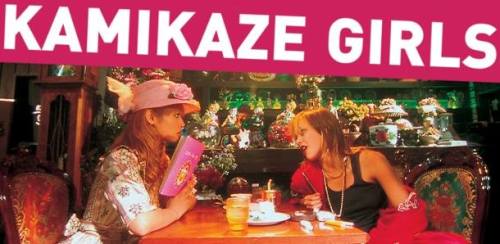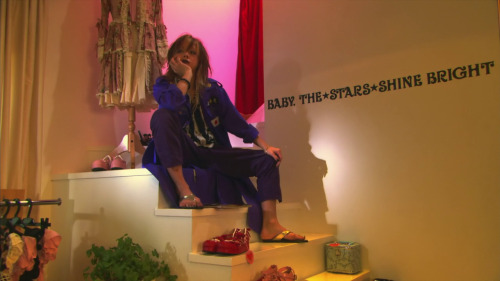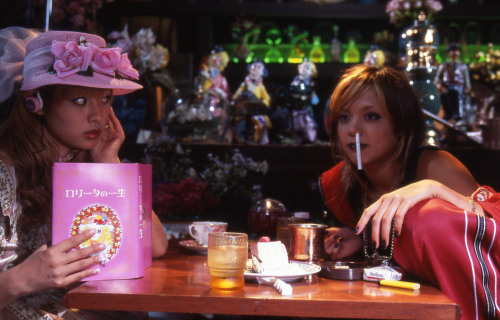Whilst everyone else is enjoying their Christmas and New Year's break here I am scrummaging time to complete my 5K analysis on the Japanese movie Kamikaze Girls, which I found it so stimulating, profoundly the most Japanese in the 21st century, arguably to give a different view how people might see it as a very Westernised product (it is but it is still Japanese through shoka). Then as I'm still struggling to write my essay I even had take the time off to share this interesting tidbits of 'did you know' and 'who knew' through my research! Procrastinating at its finest.
While still professing my new love over the heroines of the movie, Momoko and Ichiko, especially a new light to Anna Tsuchiya because I thought she was a singer but she acts so well as a yankii?! She clearly embodies that haafu personality which the director did share how Tsuchiya emulated the character in new ways out of the script.
So much research is going on to this paper and I'm having the time of my life going through my bookstack it's not even funny as there's no holiday.
To underline what I found about the relations of shojo (girls, teenage girls, adolescent girls in the global view) and pink, aka the colour for girls, and drawn into the movie, here's a visual teaser:
 |
| THE CELEBRATION OF SHOJO (GIRLS) AND PINK AT ITS FINEST |
 |
| Could you believe it, this 'scary woman' has a pink, vespa? |
 |
| Pink is so prevalent in the movie, and Ichiko as the antihesis of Momoko the pinky girl wears, obviously, the genderized color blue against pink. |
I suddenly remember Para Kissu (Paradise Kiss) and pink as it's also a very shojo story:
Off I went to Wikipedia and Answers to really get into the real answer why pink is for girls and always is associated by it, girl power... although I can't find the English text of Eva Heller's Psychology Book of Colours because she said that
"The golden age of the color pink was the Rococo Period (1720–1777) in the 18th century"I've found Natalie Wolchover added to my bibliography as it has answered another great relation from the Kamikaze Girls story itself - I mean, take a look:
As for why one color-gender pairing came to dominate over the opposite pairing, Paoletti argues that the rule we use today may reflect the influence of French fashion. Traditional French culture paired pink with girls and blue with boys (while Belgian and Catholic German culture used the opposite), and because France set the fashion in the 20th century, their tradition held sway."This happened during a time when mass marketing was appearing," Cohen told Life's Little Mysteries. "Being 'gender normal' is very important to us, and as a marketing technique, if retailers can convince you that being gender normal means you need to buy a certain product — cosmetics, plastic surgery, blue or pink clothing, etc. — it just makes sense from a production or mass marketing perspective - Source
Well, the five elements I chose that contributed the success of the movie as a transnational cinema, includes fashion and the new market of girls, the teenage boom. It was ridiculously appealing for production and consumption and within Japan especially, was the nonstop destination of affluent purchasing of luxury goods in the 90s, even for Western brand to establish exclusive 'labels' only available in the country. Moreover, Lolita fashion is about Rococo and our main star in the movie professes her soul to have lived within the Rococo era.
Mind-blowned at the moment to have discovered this integral aspect - thanks to my oddly curious thought to why Ichiko's vespa has to be pink out of all colors because she's... tough.
What a feat to find the red line between all this, the girl market has never been so dynamic, fragmented yet one brings it altogether, one here is by just the color.
Back to the essay now, clearly having new lights and materials to manifest the thoughts.
I really can't focus now. Braindrained. Tsuchiya so apt. Should stop going to Tumblr. *sigh
![[whutderrfakqizvat]](https://blogger.googleusercontent.com/img/b/R29vZ2xl/AVvXsEiYZBZMviKvEin_FsAGumBrMwpAZHcRJZO7rzq_RFYhocc90XMb6y82q4hjpnpw_ijPTAWaiReNmoQc7ham43kbZ1YiY3-qqr2rKvo7iTYPiRgkKM4BTx_5PPEx7p1GH7WBLYsAKz8e9KQ/s720/banner+4.png)

